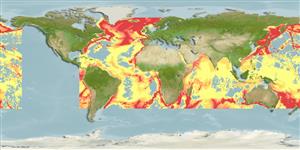>
Anguilliformes (Eels and morays) >
Synaphobranchidae (Cutthroat eels) > Synaphobranchinae
Etymology: Synaphobranchus: Greek, syn, symphysis = grown together + Greek, aphoo, aphiemi = to throw + Greek, brangchia = gill (Ref. 45335).
Eponymy: Johann Jakob von Kaup (1803–1873) was a German zoologist and palaeontologist who became the Director of the Grand Duke’s natural history ‘cabinet’ in Darmstadt. [...] (Ref. 128868), visit book page.
Environment: milieu / climate zone / depth range / distribution range
Ecologia
marino batidemersale; distribuzione batimetrica 120 - 4800 m (Ref. 50610), usually 400 - 2200 m (Ref. 58302). Deep-water; -1°C - 10°C (Ref. 26895); 69°N - 40°S, 85°W - 154°W
Eastern Atlantic: Faroes and Iceland to Cape Verde, Nigeria, Namibia (Ref. 27121), and South Africa. Western Atlantic: Greenland to Bahamas; also Brazil. Northwest Atlantic: Canada (Ref. 5951). Indo-West Pacific: Japan and Australia (Ref. 7300); absent in the Eastern Pacific except in Hawaii and the Indian Ocean.
Size / Peso / Age
Maturity: Lm ? range ? - ? cm
Max length : 100.0 cm TL maschio/sesso non determinato; (Ref. 27000)
Raggi dorsali molli (totale) : 270. Dark purplish grey in color (Ref. 3973). Anal rays about 270 (Ref. 3973).
Found on the continental slope near the upper limit of abyssal zone (Ref. 6726). Epibenthic (Ref. 58426). Probably most common in 800 to 2,000 m (Ref. 5235). Do not tolerate higher water temperatures (Ref. 5951). Feeds mainly on Decapoda, Natantia, amphipods, but also fishes and cephalopods (Ref. 6726). Caught by bottom longline and baited fish trap (Ref. 85806).
Life cycle and mating behavior
Maturità | Riproduzione | Deposizione | Uova | Fecundity | Larve
Sulak, K.J. and Y.N. Shcherbachev, 1997. Zoogeography and systematics of six deep-living genera of synaphobranchid eels, with a key to taxa and description of two new species of Ilyophis. Bull. Mar. Sci. 60(3):1158-1194. (Ref. 26895)
IUCN Red List Status (Ref. 130435: Version 2024-2)
Threat to humans
Harmless
Human uses
Pesca: di nessun interesse
Strumenti
Special reports
Download XML
Fonti Internet
Estimates based on models
Preferred temperature (Ref.
123201): 0.4 - 9.1, mean 3.4 °C (based on 3305 cells).
Phylogenetic diversity index (Ref.
82804): PD
50 = 0.5156 [Uniqueness, from 0.5 = low to 2.0 = high].
Bayesian length-weight: a=0.00059 (0.00030 - 0.00117), b=3.14 (2.96 - 3.32), in cm total length, based on LWR estimates for this species & (Sub)family-body (Ref.
93245).
Trophic level (Ref.
69278): 4.1 ±0.4 se; based on diet studies.
Resilienza (Ref.
120179): Medio, tempo minimo di raddoppiamento della popolazione 1.4 - 4.4 anni (Assuming fecundity > 100).
Fishing Vulnerability (Ref.
59153): High vulnerability (60 of 100).
Nutrients (Ref.
124155): Calcium = 16.7 [9.7, 37.5] mg/100g; Iron = 0.412 [0.206, 0.836] mg/100g; Protein = 17.4 [15.1, 19.8] %; Omega3 = 0.376 [0.157, 1.018] g/100g; Selenium = 36.5 [15.4, 82.9] μg/100g; VitaminA = 9.95 [1.98, 51.99] μg/100g; Zinc = 0.27 [0.17, 0.41] mg/100g (wet weight);
